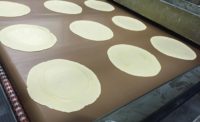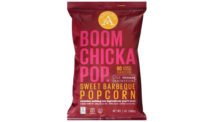Chips are a staple salty snack. And while traditional types familiar to consumers from coast to coast continue to dominate, innovation—and select forward-thinking clean-label measures—have brought diversification and growth to the segment. As a timeless, go-to lunch side and snack in the U.S., says Jill Rittenberg, global marketing manager, Potatoes USA, Denver, this segment isn’t about to slow down any time soon.
Overview | Chips | Puffed/Extruded Snacks | Popcorn | Snack Mixes & Nuts | Tortilla Chips | Pretzels | Frozen Snacks | Crackers
Market data
Potato chips make up about one-third of the massive $23.7 billion salty snacks market, accounting for $7.5 billion in sales for the 52 weeks ending April 22, 2018, per IRI, Chicago, up 2.07 percent in dollar sales.
PepsiCo’s Frito-Lay business dominates the chips segment and saw growth of 2.24 percent to $4.5 billion. Lay’s was relatively flat, up 0.84 percent to $2.2 billion, while Ruffles grew a strong 18.22 percent to $1.0 billion. The better-for-you Lay’s Oven Baked line grew 359.88 percent to $76.5 million. The recently launched Ruffles Oven Baked line brought in $43.6 million for the reporting period. Ruffles Sabritas grew by 12.04 percent to $63.7 million.
The Pringles brand accounted for most of the chips revenue for The Kellogg Co., up 3.14 percent to $741.2 million in dollar sales, per IRI; overall, the company saw $815.5 million in sales, up 0.43 percent.
Cape Cod Potato Chips grew 5.31 percent to $278.6 million. Kettle Brand also had a good year, up 6.07 percent to $213.7 million.
In other salted snacks (no nuts), the Frito-Lay SunChips brand saw a good year, up 17.43 percent to $246.0 million.
Overall, apple chips, part of the miscellaneous snacks category, had an off year, down 10.40 percent to $19.5 million. One bright spot was the Transnational Foods brand So Natural, which grew 509.89 percent to $262,239.
Looking back
“Potato chips are still one of the most-popular snacks on the market,” says Teri Johnson, divisional sales manager, TNA North America Inc., Coppell, TX. “There is a lot of opportunity for creativity in this sector that drives product development.”
New products are keeping consumers excited about their favorite snack. And potato chips are in a great position to capitalize on the adventurous and international flavor trends making waves across the food industry. “Potato chips are a comforting, American staple that also serve as a vehicle for bold, innovative flavors,” explains Rittenberg. “The chip aisle is a safe space where consumers are comfortable to branch out and try new, unique flavors and seasonings.”
Julie Balzer, senior brand manager, Kettle Brand, Salem, OR, notes that international flavors are influential in today’s potato chip market. Kettle Brand has recently looked to Mexico, Central America and South America for inspiration, leading to launches of flavors like Tropical Salsa, Krinkle Cut Spicy Queso and Chile Verde. There is also interest in specialty regional flavors that originate closer to home. This has spawned Kettle Brand’s newest flavor, Bourbon BBQ, which combines classic sweet, southern barbecue flavors with the richness of real bourbon, she notes.
Johnson has also noticed that premium ingredients like oak-smoked chiles, black truffle and cider vinegar have made their way into chip formulations.
Deep River Snacks launched Black Truffle kettle chips in July 2017. The chips are Certified Gluten-Free, made with non-GMO ingredients and contain no artificial ingredients.
But while such premium ingredients can serve as a differentiator, they can also pose challenges for manufacturers’ bottom lines. So chip manufacturers are demanding technology that can make the most of the expensive raw materials, from highly accurate seasoning technologies to high-performance fryers that maximize oil life.
SunChips has been touting its use of vegetables in its Veggie Harvest products, made with ingredients like onions, peas and tomatoes, plus whole grains. Frito-Lay also launched an LTO Sweet Potato SunChips product in fall 2017.
Looking forward
Potato chips aren’t exempt from the clean label wave. Top of mind for many manufacturers is acrylamide, a potentially cancer-causing compound produced when vegetables high in the amino acid asparagine—like potatoes—are heated to high temperatures. EU regulations now insist that food manufacturers in certain categories—including potato chips—provide evidence they have taken steps to reduce acrylamide in their production and products.
Renaissance BioScience, Vancouver, British Columbia, offers an acrylamide-reducing yeast, a non-GMO baker’s yeast that consumes the asparagine that later spawns acrylamide. Available in an active dry format, it can be added in the same manner as conventional baker’s yeast. In products like potato chips, this ingredient can be applied during the processing period. When put into a water bath with the potato slices and soaked, it helps eliminate asparagine. In one trial, it was shown to achieve a 50 percent reduction in the first minute.
“We’re finding that acrylamide is becoming an increasingly important issue for food manufacturers as governments in the U.S., Europe and elsewhere continue to press food manufacturers to ensure the presence of acrylamide in their products is as low as reasonably achievable,” says Matthew Dahabieh, chief science officer, Renaissance BioScience. “Our AR yeast is seen as a clean label solution that can deliver consistent acrylamide-reduction results.” It is currently available in parts of Europe and Scandinavia; Renaissance BioScience is currently in discussion with commercialization partners in the U.S., Canada and Asia.
At TNA North America, machinery upgrades help manufacturers exert a greater level of control over the frying process. “For example, oil flow control technology from our Florigo brand allows manufacturers to accurately control the dwell time of the chips in the hot oil to ensure that each chip is fried evenly and to perfection,” says Johnson. “At the same time, precise temperature control is essential for the production of healthy chips. With our double heat exchanges, it’s possible to lower the temperature right at the end of the frying process and, therefore, reduce the formation of acrylamide by up to 50 percent.”
TNA North America has started to equip all its continuous fryers with its patented opti-flow technology. “Normally, as the oil flow increases in the fryer so does the turbulence, which can cause the oil to spin in one place at the infeed of the frying kettle, resulting in unevenly fried potato slices and, therefore, an increase in the level of acrylamide and rejects,” Johnson explains. “However, the innovative oil inlet section at the beginning of our fryers changes the fluid dynamics within the kettle and increases oil flow speed to produce a more-streamlined laminar flow over the full width and length of the fryer pan.”
The company says this process minimizes the occurrence of turbulence by removing 99 percent of cyclone dead spots at the beginning of the fryer, thereby preventing debris from settling and ensuring that potato slices don’t absorb or carry any excess oil. “As a result, each potato chip is evenly fried, lowering the level of acrylamide and reducing the number of rejects for enhanced product quality and increased yield,” says Johnson.
These developments will be welcome additions to the market, as consumers continue to demand better versions of their favorite snacks, whether that means lower acrylamide levels or new flavors breaking onto the scene seemingly daily. “Potato chip manufacturers can draw inspiration from the expanding competition,” says Rittenberg, “but rest assured that potato chips are a beloved, craveable mainstay in the U.S.”
Overview | Chips | Puffed/Extruded Snacks | Popcorn | Snack Mixes & Nuts | Tortilla Chips | Pretzels | Frozen Snacks | Crackers







